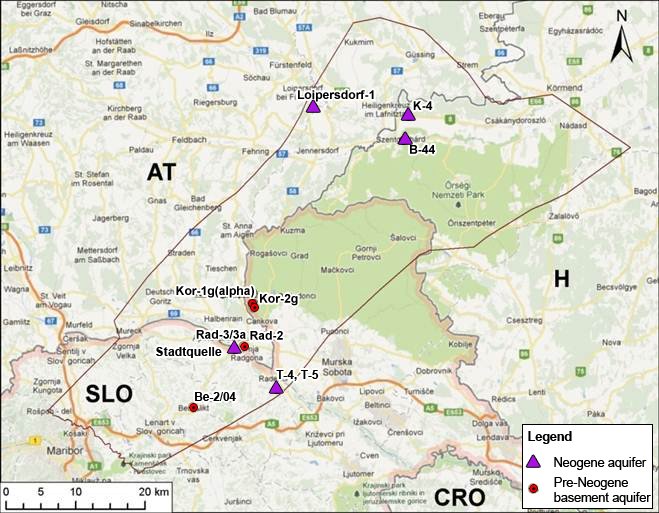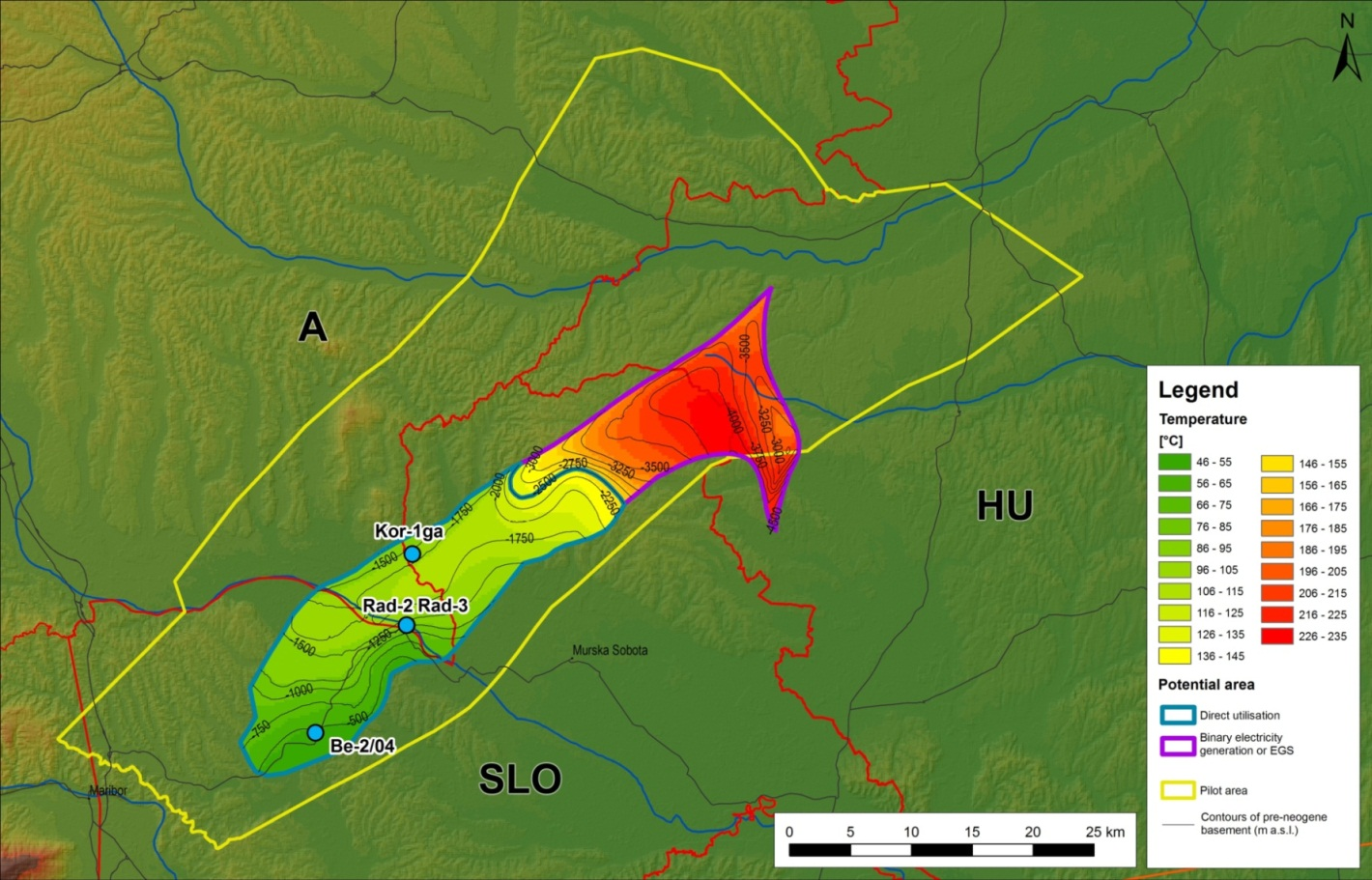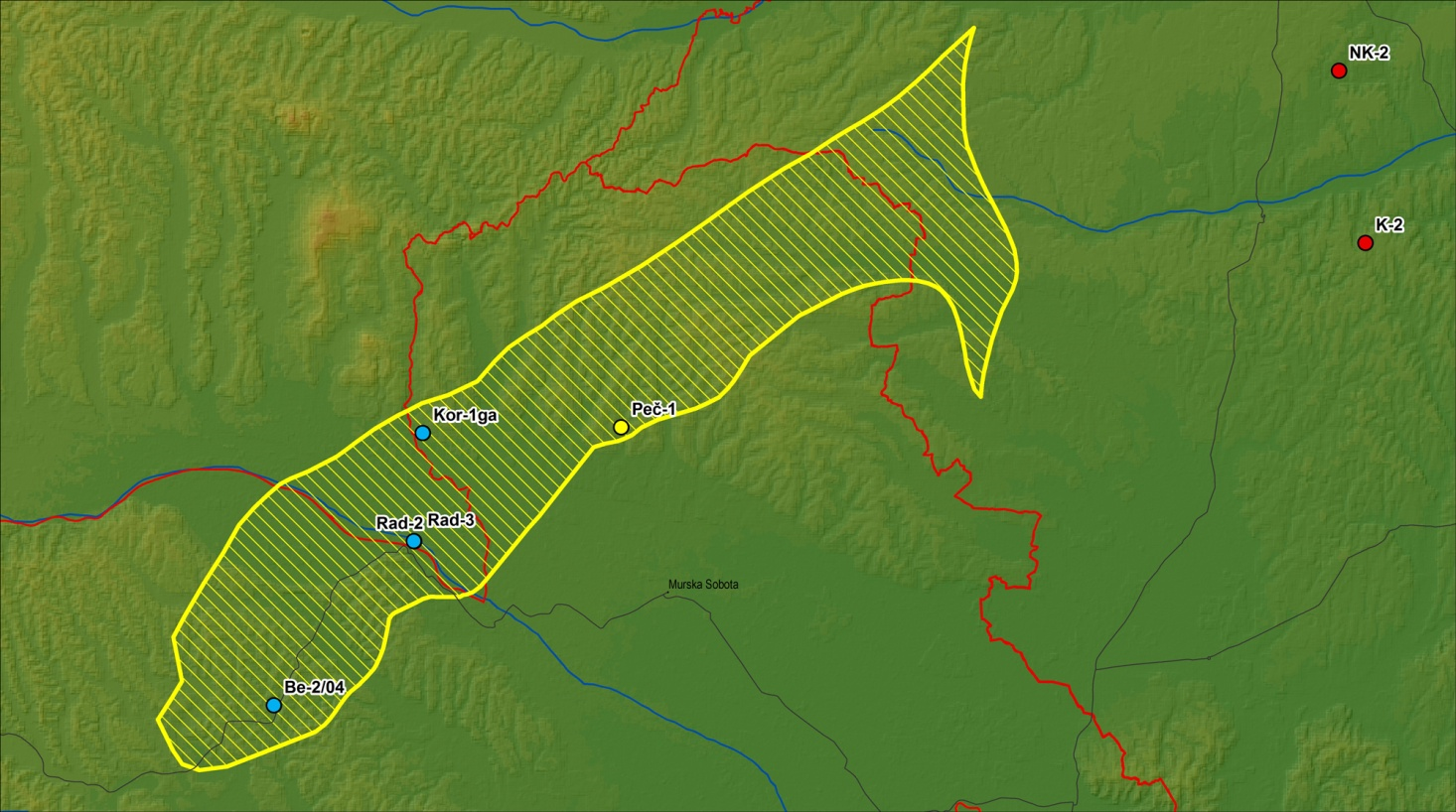The Bad Radkersburg - Hodoš Pilot Area
By Andrej Lapanje, Nina Rman, Mitja Janža, Tadej Fuks, Dejan Šram
The Bad Radkersburg – Hodoš pilot area is situated along the national borders of Austria, Slovenia and Hungary. It covers an area of 2078 km2, of which 40% belongs to Slovenia, 32% to Austria and 28% to Hungary (Figure 1). Around 110 000 inhabitants live on this area. The biggest settlement is Szentgotthard (HU) with more than 8000 inhabitants, followed by Jennersdorf (AT), Gornja Radgona, Lenart and Radenci (SI). Land use is predominantly agricultural, but machine industry and tourism are also important.

Figure 1 : Geographical settings of the Bad Radkersburg-Hodoš pilot area
- Hydrogeology
There are three main aquifers which produce thermal water. The Upper Miocene Mura/Újfalu sandy aquifer is exploited in the Mura-Zala basin near Szentgotthard (HU), while the Middle Miocene sandstone aquifer in Bad Radkersburg, Radenci and near Loipersdorf in the Styrian basin. The investigated Pre-Neogene basement aquifer is set in the Mesozoic carbonate and Paleozoic fissured metamorphic rocks within the Raba fault zone in SWS – ENE direction (Figure 2). The assumed thermal water flow direction in the latter aquifer is SW - NE.
- Geothermal conditions
Temperature at depth of 1000 m varies between 38 and 80°C, with the highest values at Benedikt and Murska Sobota high. Temperatures at 2500 m are between 94 and 118°C, with higher values towards NE, while 170 to 240°C are calculated at 5000 m. Temperatures at the top of Pre-Neogene basement rocks rise in the same direction as the basement deepens, and comes close to 200°C at 4 km.

Figure 2 : Depth and temperature at the top of the Pre-Neogene basement aquifer
Current state of utilization and future challenges
- Current utilization
The Upper Miocene Mura/Újfalu sandy aquifer is exploited for balneological and agricultural use by 2 wells in Szentgotthard (HU). The water from the Middle Miocene sandstone aquifer in used for balneology, and produced by one well in Loipersdorf, and in Bad Radkersburg (AT) and one in Radenci (SI). Exploitation of thermomineral water from the Pre-Neogene basement aquifer occurs in transboundary zone between Austria and Slovenia. Two wells in Bad Radkersburg (AT) produce it for balneology, while the well in Benedikt (SI) for district heating. A research borehole in Korovci (SI), less than 5 km away from Bad Radkersburg (AT), tapped the same aquifer in 2008 but its development is currently at a standstill.
- Summary of utilization
Geothermal site |
Aquifer |
Thermal water use |
Actual production (m3/year) |
Water permit (m3/year) |
Szentgotthard (HU) |
Upper Miocene |
Bathing and balneology, drinking water |
60 000 |
No information |
Radenci (SI) |
Middle Miocene |
Bathing and balneology |
8000 |
31 500 |
Loipersdorf (AT) |
No information |
157 680 |
||
Bad Radkersburg (AT) |
No information |
73 000 |
||
Bad Radkersburg (AT) |
Pre-Neogene basement
|
No information |
700 000 |
|
Benedikt (SI) |
District heating |
65 000 |
315 360* |
|
Korovci (SI) |
No use |
0 |
158 000* |
* This is only an informative amount, as the applications are not yet granted
- Existing and probable future conflicts
Drinking water resources do not compete with thermal water exploitation in this area, as in many cases the latter is too mineralized to be used for drinking. There is a competition between an existing thermal water user of the Pre-Neogene basement aquifer in Bad Radkersburg (AT) and a developer in Korovci (SI). The latter plans to reinject part of the water which will be used for heating, but the one used for balneology will have to be treated on a purifying plant to prevent pollution of the transboundary stream Kučnica. The monitoring data on Austrian wells is not available, and therefore the assessment of impact of Korovci to this site is uncertain. No quality or quantity changes have been reported for thermal water abstracted from the Pre-Neogene basement aquifer.
- Present state of management and protection of existing uses
Zones of concessions are proposed for Benedikt and Korovci sites (SI) as the whole outlined basement aquifer (Figure 3 ), but the concessions have not been granted yet. No protection zones are outlined in Austria. The Mura commission has discussed the Bad Radkersburg-Korovci conflict but very poor data exchange exists among the two countries. Only harmonized transboundary monitoring system will enable evaluation of the environmental impacts of utilisation and interference between these current and potential users.
- Present and possible future impacts
Waste thermal water is treated at a sewage purifying plant in Bad Radkersburg and Loipersdorf (AT) before it is released to the Mura River and Jennersbach channel. In Benedikt (SI), the water is cooled but chemically untreated before it flows to Drvanja stream, while in Radenci (SI) it is cleaned at a purifying plant. Thermal efficiency of balneological use in Bad Radkersburg is 9%, while it reaches 45% for district heating in Benedikt. Reinjection is not applied anywhere, but it is foreseen in Korovci (SI).
- Main objectives and questions to be answered
What are characteristics of groundwater water flow in the Pre-Neogene basement aquifer, regarding the recharge/discharge area, flow magnitude and direction? Do geothermal wells which tap this aquifer hydraulically interfere and to what extent? Is there a possibility that the Korovci (SI) planned geothermal doublet will have an impact on the Bad Radkersburg (AT) wells? What kinds of measures are needed to reach sustainable utilisation of this aquifer?
Present and Future Hydrogeothermal Resources
Table 1 : Characteristics of the Pre-Neogene basement aquifer (Figure 2 )
Parameter |
Value |
Geological settings |
Radgona-Vas tectonic half-trench |
Area |
470 km2 |
Rock type |
Mesozoic carbonate and Paleozoic metamorphic rocks |
Porosity type |
Fissured and fractured reservoir |
Top of reservoir |
290 m b.s.l. in SW (545 m below the ground), It deepens to over 5000 m b.s.l. (5350 m below the ground) in NE |
Bottom of reservoir |
Not known |
Porosity |
0.2 |
Hydraulic conductivity |
10-6 m/s |
Groundwater flow |
SW-NE direction, no surface discharge features |
Geothermal features |
Local convection cells (Benedikt) |
Existing utilization |
3 wells (balneology, heat) |
Ways towards a sustainable future management
- What can be derived from the utilization assessment (WP3)?
The Pre-Neogene basement aquifer is currently underdeveloped since only three wells produce thermal water. The produced water temperature is about 80°C, which is applicable for direct heat use and balneology but not for geothermal electricity production. Thermal efficiency of applied systems is rather low and no reinjection has been performed.
- How can the elaborated steady state models help to manage future utilization?
Elaborated steady state model is the first numerical representation of geothermal conditions in the pilot area which is the basis for future efficient management and sustainable utilisation. It Due to paucity of information, it is based on many assumptions. Baseline monitoring and additional research are essential to improve the uncertainty of the model results. The model provided initial conditions for the scenario modelling. It indicated the highest temperatures in the NE part of the pilot area and possibility of convective heat transfer in the Benedikt area. Due to geological settings and the model results it is possible that local convection cells are developed also elsewhere, beside Benedikt.
- What can be learned from the scenario modelling?
Two types of scenarios which included existing exploitation in Benedikt and Bad Radkersburg were tested; thermal water production of 20 l/s in Korovci with and without reinjection applied. According to these scenarios, the thermal water demand is lower than the identified potential in the simulated 50-year period. Hydraulic influence of a production well in Korovci has a negligible effect on the Bad Radkersburg site. These results point out that the interference between Korovci (SI) and Bad Radkersburg (AT) sites is not expected if there are no preferential flow paths along well permeable faults. Consequently, the planned exploitation of a geothermal doublet in Korovci can be realized, but joint transboundary monitoring has to be managed in both countries to identify and mitigate potential undesirable effects of this enhanced exploitation.
- Future joint resource assessment, monitoring and reporting strategies
Monitoring of existing users is not operational in Slovenia, while the data is confidential in Austria. In this pilot area no bilateral monitoring or reporting procedures have been implemented. In bilateral SI-AT Mura commission on water management this issue has been raised for several years, but no conclusions have been done, but a common surveillance of the pumping test in was performed Korovci in 2009.
We recommend establishing a joint transboundary harmonized and systematic monitoring of the Pre-Neogene basement aquifer by establishing a bilateral database of baseline and production data. This should be supplemented by running production monitoring of three wells in Benedikt (SI) and Bad Radkersburg (AT), and passive monitoring of one inactive production well in Korovci (SI) and one observation well in Pečarovci (SI). There are no applicable wells in Hungary (Figure 3). Moreover, evaluated and calibrated bilateral numerical models for allowance and water permissions should be ran simultaneously. Detailed information is awailable in reports Catalogue of monitoring and reporting measures and Detailed cross-border monitoring and reporting assessment of pilot areas.

Figure 3 : Proposed joint Bad Radkersburg - Hodoš monitoring network
- Future management strategies
Application of geothermal doublets (a pair of production and reinjection well) is highly recommended due to technical and environmental benefits, plus due to a very limited recharge. New users should exploit the available heat in a very thermally efficient (above 70%) cascade use, where sequential heat exchangers will decrease the temperature of waste thermal water prior reinjection to a maximum of 40°C, and prior surface water emission to below 20°C.
- Mitigation of environmental impact
Because of high mineralization and scaling potential of the produced thermomineral water from the Pre-Neogene basement aquifer, possible chemical and thermal pollution of surface waters, and uncertain but probably poor recharge of the aquifer, the exploitation of this transboundary aquifer is highly recommended to be done with the use of geothermal doublets.
- Which are the main obstacles towards a future joint thermal water management
There is not much interest in solving this transboundary issue at the moment, as the user site in Korovci stopped developing due to lack of financial resources for investment. When there will be political interest, legislations on Water, Mining etc. will have to be adjusted as recommended in the Strategy paper. Major obstacles found are also confidentiality of production data in Austria and general lack of hydrogeological information on deeper parts of the aquifer. We believe that additional research is needed to better describe the hydrogeological system.
The Web Based Information Tool
The Web based Information Tool on hydrogeothermal resources in the Bad Radkersburg - Hodoš Pilot Area aims to give an overview about identified relevant hydrogeothermal reservoirs, summarized at so called “Hydrogeothermal Plays” in order to support decisions towards a possible future transnational management of natural thermal water resources. It addresses governmental authorities, decision makers, possible investors as well as experts and the interested public. However, it does not aim to replace detailed surveys or feasibility studies, as most of the published results are presented at a regional geographical level.
The Web Information Tool consists of the following products:
- A detailed Web-Map Service of the Bad Radkersburg - Hodoš Pilot Area focusing on the identified Hydrogeothermal Plays.
- The results of the achieved resource assessment for the identified Hydrogeothermal Plays
The Web Based Information Tool summarizes the main results of Transenergy and intends to inform, raise awareness and provide sound base data and models.
Web Map Services for the Bad Radkersburg - Hodoš Pilot Area
The individual Web Map Service for the Bad Radkersburg - Hodoš Pilot Area shows relevant reservoir data for the Hydrogeothermal Plays.
For the pilot area the following list of contents concerning the Web-Map-Service has been chosen:
- Temperature distribution at the top of the selected Hydrogeothermal Play [°C].
- Existing Utilizations.
- Pressure / hydraulic potential.
- Groundwater levels after 50 years of exploitation.
All presented layers are derived from regional geological and numerical models achieved during Transenergy. They intend to give an overview about the regional scale geothermal conditions at the identified Hydrogeothermal Plays.
Manual
The pilot area Web-Map-Service is very similar to the Transenergy Web-Map-Service for the supra-regional project area. In order to view the manual click here.
Disclaimer
Data available within the web map application is provided only for a regional overview of geological and geothermal conditions of the TRANSENERGY pilot area Bad Radkersburg - Hodoš and should not be used for more local potential/reservoir assessment. No permission is granted for use of the data outside this application without written permission of the owner of the data. For further information please contact our project partners.